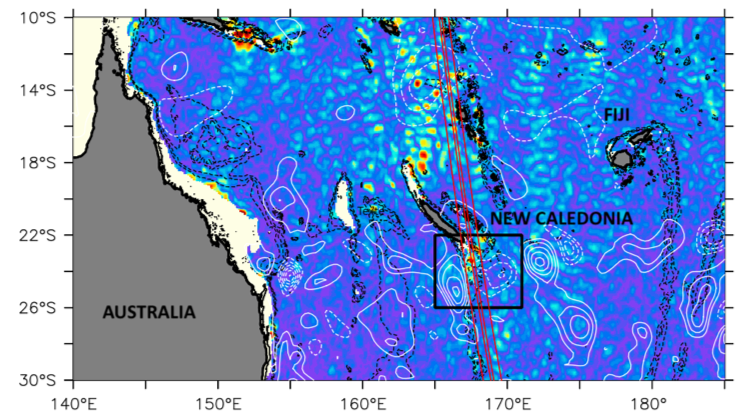In preparation for the future SWOT mission, significant efforts focused on estimating the signature of internal tides over the global ocean from altimetry and models (Shriver et al., 2014; Ray and Zaron, 2016; Zhao et al., 2016). A lot of work has been done in recent years to document and disentangle the signature of submesoscale features and internal tides on SSH (Qiu et al., 2018; Torres et al., 2018). This transition scale falls at 40-100 km in the interior subtropics, and exceeds 200 km in the tropical ocean. Such a spatial scale is large enough to expect strong interactions between internal tides, currents and meso/submesoscale eddies that are a source of the incoherence of internal tides. Whereas coherent tides (with fixed phase and amplitude) are possibly predictable, incoherent tides are much more problematic to detect and predict, and may compromise the ability of future wide-swath altimetric missions to observe submesoscale circulation. Better understanding how internal tides become incoherent and sign in SSH is thus a critical issue. Our project is motivated by the SWOT SSH observability of the meso/submesoscale range (15-100 km wavelength) in a tropical region where internal tides and mesoscale eddies have similar amplitude and are supposed to strongly interact. Such region must be close to the critical latitude separating non-linear dynamics of the mid-latitudes from linear dynamics of the equatorial band (~25°NS, Theiss, 2004; Klocker et al., 2016). The choice of the region is the area South of New Caledonia (SNC).
contact: Lionel Gourdeau, Sophie Cravatte, Frédéric Marin.
SWOT observability of internal tide and eddy interactions around New Caledonia
The future SWOT (Surface Water and Ocean Topography) mission scheduled for launch in 2022 will revolutionise satellite altimetry by resolving the surface ocean at scales one order of magnitude higher resolution than conventional alimetry representing the transition from nadir to wide-swath altimetry. Resolving the finest scales including mesoscale to submesoscale turbulence and internal tides, it is important to understand how and to what extent these dynamics contribute to sea surface height amplitude in order to evaluate SWOT measurements.
New Caledonia represents the ideal study region as it is characterised by strong mesoscale and submesoscale eddy activity, intense internal tides, and possibly strong interactions between each other. Moreover, the research area is beneath SWOT’s fast-sampling trajectory. As part of the project « SWOT in the Tropics » (Gourdeau, L., Cravatte, S., Marin, F.), the study is dedicated to (1/60°) high-resolution modelling in preparation for an in-situ experiment planned during the SWOT fast-sampling phase to survey the three dimensional fine-scale dynamics south of New Caledonia and to compare and validate with the satellite measurements.
contact: Arne Bendinger
